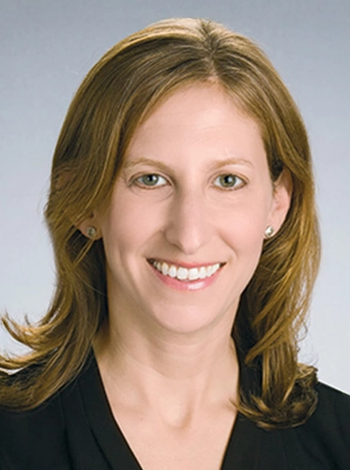
Reducing EHR headaches with ‘virtual’ scribes
Scribes are someone who works offsite or in a different area of the practice (ie, not in the exam room) to document important aspects of the encounter so the physician or other provider can focus on providing patient care and working more efficiently.
Ellen Hight, M.D., a family medicine physician in East Greenwich, Rhode Island, says the electronic health record (EHR) completely changed her practice, and not necessarily in a good way. “When our practice started using an EHR, I began to feel a distance between myself and my patients because I was constantly staring at the computer,” she says. Her work-life balance also took a hit as she began to spend Saturday mornings finishing her notes from the previous week.
When the Rhode Island Primary Care Physicians Corporation (RIPCPC), an independent practice association to which her practice belongs, approached her about piloting a virtual scribe program — and said it would pay for the first two months of participation — she jumped at the opportunity. “When I heard about virtual scribes, I thought, ‘Well that’s a good idea,’ ” she recalls.
Scribes are someone who works offsite or in a different area of the practice (i.e., not in the exam room) to document important aspects of the encounter so the physician or other provider can focus on providing patient care and working more efficiently.
RIPCPC partnered with an outsourced virtual scribe vendor to launch the two-month pilot program that included Hight, one other physician, and one nurse practitioner. Hight says the pilot was a huge success, prompting her to continue working with the scribe, a dentist in India. “My hands are not on the keyboard and I’m looking directly at the patient,” says Hight. “It’s more personal. I just feel so much more relaxed.”
Greater efficiencies enable Hight to see six or seven additional patients a day without putting in extra hours. She also usually does not take work home at night or on weekends.
The other physician who participated in the pilot continues to use a virtual scribe. Hight’s still assessing whether it makes financial sense for the nurse practitioner (who bills under her own national provider identifier rather than incident-to a physician) to continue.
Maximizing efficiency, revenue
Jonathan Weiss, MD, internist in Monticello, New York, has used a domestic virtual scribe for the last four years and says his scribe does just about everything except take vital signs, draw blood, perform electrocardiograms and administer vaccines. For example, in addition to completing all relevant documentation, the scribe listens to the doctor’s verbal instructions and then orders tests, initiates referrals, messages relevant office staff to obtain prior authorizations and checks off boxes in the EHR for quality measures. She even navigates to different parts of the record to retrieve information for Weiss upon request.
“To me, virtual scribing is one of the holy grails of making medicine tolerable again,” says Weiss. “During a 15-minute established patient visit, I can produce an incredibly well-documented note, get all the tests ordered and stay on schedule. In the majority of cases, I can legitimately obtain a higher E/M (evaluation and management) level because my notes are so robust. Ten minutes after my last patient, I’m in the car and headed home.”
Weiss is also able to see an additional three or four patients per day without extending his hours. Previously, he would have stayed until 8 p.m. and paid his staff overtime. In addition, his medical assistant is not tied to the computer and can engage patients more directly.
“Working with a remote scribe has been the single most work-changing thing I’ve done in 15 years,” he says. “If it was taken away from me, I would quit my job. I could not go back to the way I was doing things before.”
Addressing physician burnout, turnover
At UW Health, an integrated health system of the University of Wisconsin-Madison serving more than 700,000 patients each year in the Upper Midwest, working with virtual scribes was part of a deliberate effort to reduce physician burnout, says Christine Williams, director of health information management.
“Providers didn’t go to school to document. They went to school to practice medicine and make a difference,” says Williams. “With virtual scribes, physicians can stay connected to the patient. This is true whether it’s a small practice or a large academic medical center.”
Physicians at UW Health have the option of working with a virtual scribe. If they opt in, they are required to see one additional patient per session (i.e., every four hours). This additional revenue covers most of the cost of the scribe, says Williams.
UW Health began its scribe offering with a pilot program in 2019 that subsequently converted into a permanent program focused on ambulatory providers. Williams says she eventually wants to include emergency department physicians and hospitalists. Approximately 150 ambulatory providers currently use virtual scribes with an additional 10 providers joining each month.
Why offer a virtual scribe program? Preventing burnout ultimately reduces costly physician turnover, says Williams. “Physician resignation and needing to fill vacancies is a very large cost, especially for small practices,” she adds.
Matthew Malek, M.D., M.P.H., family medicine physician and medical director of provider experience at Thundermist Health Center, a federally qualified health center in Rhode Island, agrees. “If you can prevent one physician from leaving, this is an incredible savings on the order of $300,000 to $500,000,” he says.
Why are the costs so high? First, it takes time to find and hire a new provider. “When you consider the lack of billing during this time, that’s a big chunk of change,” says Malek.
It also takes time for physicians to build a patient panel and maximize efficiency. “At our organization, it takes about a year for a new physician to get to their eventual baseline productivity,” he adds.
Using virtual scribes at Thundermist Health Center was a data-driven decision, says Malek, who was instrumental in launching the program. The health center partnered with the American Medical Association to assess physician well-being using the Mini Z 2.0 burnout survey. It also used a set of validated questions about efficiency of practice and teamwork as well as community self-reported data. Finally, the health center tracked an EHR-based metric called the WOW8 to objectively measure work outside of office hours. This metric is defined by time on the EHR outside of scheduled patient hours per eight hours of patient scheduled time.
“We realized that our clinicians were spending a lot of time outside of the clinical work doing clinical documentation,” he says. “We had the data to bring to leadership to justify the virtual scribes.”
The pandemic was the perfect backdrop for a virtual program. “We also use remote scribes in our COVID(-19) evaluation and treatment clinics,” he says. “It’s nearly impossible to fit three people in an exam room and maintain appropriate distance.”
Now that the program is up and running, physicians choose whether to participate. If they do, they also decide how many hours they would like to work with the scribe. However, the vendor requires a minimum of four continuous hours and 50 total hours per month. Thundermist requires physicians using scribes to add roughly two visits per day to cover the cost, says Malek.
“The maturation of the scribe market makes it a much more understandable value proposition,” he adds. “I think remote scribing is a very scalable intervention to improve physician well-being.”
Strategies for success
Think a virtual scribe may be what you’re looking for? Industry experts provide six tips to help you succeed.
1 Determine your “why.” Are you exploring a virtual scribe program to address burnout concerns and prevent attrition? See additional patients and generate more revenue? See the same number of patients in the same or fewer hours? Improve patient satisfaction?
Knowing the why helps physicians gauge impact and return on investment, says Sean M. Weiss, chief compliance officer at DoctorsManagement, LLC, adding that some physicians work with virtual scribes simply to ensure timely, accurate documentation that establishes medical necessity for services rendered. Your why will determine the key performance indicators necessary to measure the success of the program. Examples might include physician and staff turnover rates, physician self-reported data related to well-being, or patients seen per hour.
2 Vet vendors carefully. Experts recommend asking these questions:
What type of training or credentials do the virtual scribes have? For example, are they an RN, LPN, or have some other medical training?
What type of ongoing education for medical specialties, terminology, anatomy, physiology and pharmacology do they receive?
What is their knowledge of medical coding and clinical documentation requirements (including CPT modifiers and quality measures)?
What is the vendor’s plan if a virtual scribe is suddenly unavailable (e.g., due to sickness, vacation or turnover)? Can it provide immediate backup coverage?
3 Do not overlook cybersecurity. “There’s a significant risk of using remote scribes and really any third-party vendor, and it’s not getting the attention it should,” says Sean Weiss. “That risk is the risk of cyberattack.” He says most breaches occur through third-party vendors such as outsourced billing/coding companies, outsourced release of information vendors, virtual scribes and others.
Sean Weiss points to a recent case in Florida in which a hacker fraudulently billed $10 million to Medicare by gaining access to patients’ protected financial information, demographics, diagnostic information and the provider’s UPIN (unique physician identification number). “The group practice actually had a strong cybersecurity protocol, but this individual was able to hack into the system through the third-party vendor,” he says.
Experts agree that practices intending to work with a virtual scribe should ask these questions of the vendor employing the scribe:
What is the risk management plan in place to test the system, and how often do these tests occur?
What were the results of the most recent risk assessment?
What corrective action plan, if any, was implemented?
Has the vendor ever experienced a cyberattack?
What is the vendor’s plan for business continuity during downtime due to a cyberattack?
What is the risk management strategy going forward? For example, does each virtual scribe have their own login information? Do they receive ongoing HIPAA (Health Insurance Portability and Accountability Act of 1996) training?
4 Set realistic expectations. “A scribe can be trained by someone else on how to navigate the EMR (electronic medical record), but the provider really needs to train the scribe on their specific dictation style and workflow,” says Williams. This process could take a few weeks and physicians need to be on board with the upfront work that’s required, she adds.
5 Perform a pilot program. “This ensures it fits within the autonomy of that practice specifically,” says Williams. “It ensures you’re not interrupting five or 10 clinicians at a time. You have one or two who are really committed to working out some of the kinks. It’s not just plug and play.” For example, practices will need to ensure processes for patient notification and reviewing documentation for billing and compliance purposes.
6 Think beyond traditional scribing roles. “If physicians are only asking for documentation, they’re missing half the boat,” says Jonathan Weiss. “They should be pushing scribes to be a virtual medical assistant. You get much more value for your dollar.”
Newsletter
Access practical, evidence-based guidance to support better care for our youngest patients. Join our email list for the latest clinical updates.








